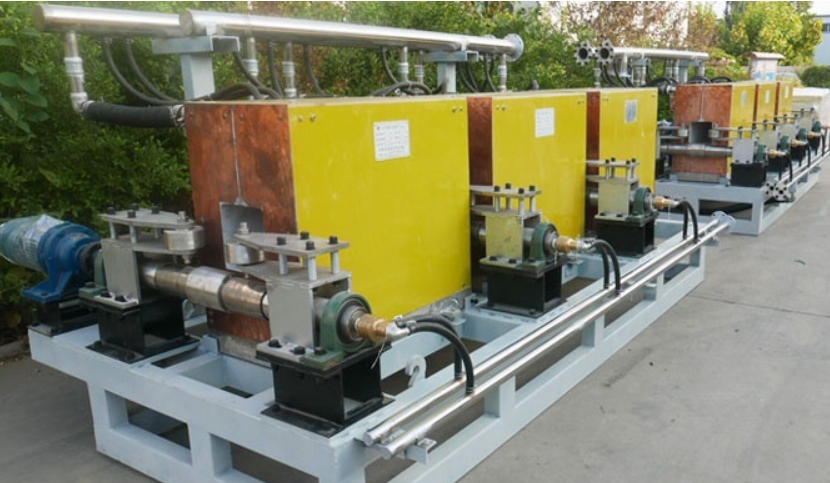- 20
- Oct
Direct Hot Rolling Technology of Continuous Casting Billet (CC-HDR)
Direct Hot Rolling Technology of Continuous Casting Billet (CC-HDR)
In the early stage of the continuous casting process, the section of the cast slab is small, the temperature drops quickly, and the quality of the cast slab is poor. Therefore, surface finishing is required before rolling, so cold billet reheating is used. This wastes a lot of energy. In the 1980s, after long-term research, Nippon Steel Corporation successfully developed wide-section continuous casting slab hot delivery and hot charging and even hot direct rolling processes, which greatly improved the compactness of continuous casting and continuous rolling. Significantly save energy. In order to realize the hot delivery and direct rolling of continuous casting billets, the following complete sets of technologies are required as a guarantee, namely:
(1) Non-defect slab manufacturing technology;
(2) On-line detection technology for cast slab defects;
(3) Using latent heat of solidification to produce high-temperature continuous casting slab technology;
(4) On-line rapid slab width adjustment technology;
(5) Continuous heating and rolling temperature control technology;
(6) Computer management and scheduling system for process.
According to the different slab temperature levels that can be obtained, the continuous casting-continuous rolling-integration process can be divided into:
(1) Low-temperature hot delivery of continuous casting slab-reheating rolling process (from above);
(2) Continuous casting billet high temperature hot delivery and rapid reheat rolling process (above excellent);
(3) Continuous casting billet (four corner heating) direct rolling process.
The continuous casting direct rolling developed by Nippon Steel’s Sakai Plant uses electromagnetic induction rapid heating (ETC) temperature compensation for the four corners of the high-temperature cast slab, which can be directly rolled into hot-rolled coils.
Large-scale steel plants in my country (such as Baosteel, etc.) that produce high-quality plates have also successfully achieved direct hot rolling of continuous casting slabs.
Near-net-shape continuous casting (thin slab continuous casting) is a new continuous casting process developed in the 1990s. Since its birth, it has been designed as a continuous production line with a continuous rolling mill. When the continuous casting billet is not completely solidified, light reduction can be performed online, and the temperature of the continuous casting billet can be kept above the line when it enters the rolling mill, that is, it has not undergone the transformation from austenite (Y phase) to ferrite (a phase). Rolled into steel sheet directly in the state of primary austenite phase. Chinese scholars have found that the steel produced in this way does not produce secondary austenite during rolling (a ^7) and the corresponding redissolution of the dispersed precipitate phase, so the thin plate produced by near-net-shape continuous casting Precipitation hardening precipitates can become nano-sized particles, which have an excellent effect on the quality of steel. my country has built 12 production lines for thin slab continuous casting, and the annual output occupies a very important position in the world.
Billet continuous casting is essentially near-net-shape continuous casting. It was researched and developed earlier, and was successfully used in the 1960s. Due to the knowledge and comprehensive technical level at that time, cold billet reheating rolling was mostly used. my country vigorously promoted the billet continuous casting technology in the 1980s, combined with my country’s national conditions, combined with small converters (30t) and high-speed wire rod mills to form a general carbon steel long product line, with high productivity (a lot of those with an annual output of 1 million tons or more) ), with low investment and strong competitiveness in steel for construction. The demand for construction steel in my country is large, and the long product market is also very broad. Therefore, this small converter-billet continuous casting-high-speed wire rod mill production line occupies a considerable proportion of my country’s steel production. In addition, billet continuous casting also has certain advantages in low-alloy steel structural steel long products (such as ball bearing steel, steel for machinery manufacturing). In order to improve production efficiency and save energy, hot delivery and hot charging of cast slabs has also been paid more and more attention. However, limited to the original design conditions, it is no longer easy for the slab temperature to reach 700 RON, and many heat preservation measures need to be taken. The reheating of the billet mostly uses a fuel-burning heating furnace. my country Zhenwu Electric Furnace Co., Ltd. proposed and designed a method for on-line rapid heating of cast slabs by electromagnetic induction. Its advantages are as follows:
(1) The heating time of the billet in the intermediate frequency furnace is much shorter than the time required for it to be heated in the flame furnace, which not only helps to reduce the iron loss, but also improves the surface quality of the cast slab during the rolling process;
(2) Using electromagnetic induction heating, there are no combustion products in the heating zone, thereby effectively avoiding the oxidation and decarburization of the cast slab, so that a clean billet can be obtained through this rapid heating;
(3) Since the induction heating furnace has no combustion products, it is environmentally friendly and greatly reduces heat radiation;
(4) The induction heating furnace is not only more convenient, quick and accurate to automatically control the temperature, but also can save energy;
(5) The induction heating furnace is used to heat the billet, and the equipment maintenance cost is much smaller than that of the flame furnace;
(6) Induction heating billets can heat super-long billets more conveniently, which is beneficial to realize semi-endless rolling and improve rolling efficiency.

